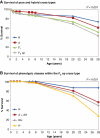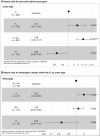Expansion of the rare Eucalyptus risdonii under climate change through hybridization with a closely related species despite hybrid inferiority
- PMID: 34351372
- PMCID: PMC8752398
- DOI: 10.1093/aob/mcab103
Expansion of the rare Eucalyptus risdonii under climate change through hybridization with a closely related species despite hybrid inferiority
Abstract
Background and aims: Hybridization is increasingly recognized as an integral part of the dynamics of species range expansion and contraction. Thus, it is important to understand the reproductive barriers between co-occurring species. Extending previous studies that argued that the rare Eucalyptus risdonii was expanding into the range of the surrounding E. amygdalina by both seed and pollen dispersal, we here investigate the long-term fitness of both species and their hybrids and whether expansion is continuing.
Methods: We assessed the survival of phenotypes representing a continuum between the two pure species in a natural hybrid swarm after 29 years, along with seedling recruitment. The performance of pure species as well as of artificial and natural hybrids was also assessed over 28 years in a common garden trial.
Key results: In the hybrid zone, E. amygdalina adults showed greater mortality than E. risdonii, and the current seedling cohort is still dominated by E. risdonii phenotypes. Morphologically intermediate individuals appeared to be the least fit. Similar results were observed after growing artificial first-generation and natural hybrids alongside pure species families in a common garden trial. Here, the survival, reproduction, health and growth of the intermediate hybrids were significantly less than those of either pure species, consistent with hybrid inferiority, although this did not manifest until later reproductive ages. Among the variable progeny of natural intermediate hybrids, the most E. risdonii-like phenotypes were the most fit.
Conclusions: This study contributes to the increasing number of reports of hybrid inferiority in Eucalyptus, suggesting that post-zygotic barriers contribute to the maintenance of species integrity even between closely related species. However, with fitness rapidly recovered following backcrossing, it is argued that hybridization can still be an important evolutionary process, in the present case appearing to contribute to the range expansion of the rare E. risdonii in response to climate change.
Keywords: Eucalyptus amygdalina; Eucalyptus risdonii; fitness; hybrid inferiority; hybrid swarm; hybrid zone; hybridization; outbreeding depression; post-zygotic barriers.
© The Author(s) 2021. Published by Oxford University Press on behalf of the Annals of Botany Company. All rights reserved. For permissions, please e-mail: journals.permissions@oup.com.
Figures








Comment in
-
Long-term research reveals potential role of hybrids in climate-change adaptation. A commentary on 'Expansion of the rare Eucalyptus risdonii under climate change through hybridisation with a closely related species despite hybrid inferiority'.Ann Bot. 2022 Jan 8;129(1):i-iii. doi: 10.1093/aob/mcab085. Ann Bot. 2022. PMID: 34289013 Free PMC article.
Similar articles
-
Long-term research reveals potential role of hybrids in climate-change adaptation. A commentary on 'Expansion of the rare Eucalyptus risdonii under climate change through hybridisation with a closely related species despite hybrid inferiority'.Ann Bot. 2022 Jan 8;129(1):i-iii. doi: 10.1093/aob/mcab085. Ann Bot. 2022. PMID: 34289013 Free PMC article.
-
Molecular insights into the dynamics of species invasion by hybridisation in Tasmanian eucalypts.Mol Ecol. 2023 Jun;32(11):2913-2929. doi: 10.1111/mec.16892. Epub 2023 Feb 27. Mol Ecol. 2023. PMID: 36807951
-
HYBRIDIZATION AS A DISPERSAL MECHANISM.Evolution. 1988 Nov;42(6):1245-1255. doi: 10.1111/j.1558-5646.1988.tb04184.x. Evolution. 1988. PMID: 28581069
-
Hybridization and hybrid speciation under global change.New Phytol. 2016 Sep;211(4):1170-87. doi: 10.1111/nph.14004. Epub 2016 May 23. New Phytol. 2016. PMID: 27214560 Review.
-
The evolutionary outcomes of climate-change-induced hybridization in insect populations.Curr Opin Insect Sci. 2022 Dec;54:100966. doi: 10.1016/j.cois.2022.100966. Epub 2022 Sep 9. Curr Opin Insect Sci. 2022. PMID: 36089267 Review.
Cited by
-
Long-term research reveals potential role of hybrids in climate-change adaptation. A commentary on 'Expansion of the rare Eucalyptus risdonii under climate change through hybridisation with a closely related species despite hybrid inferiority'.Ann Bot. 2022 Jan 8;129(1):i-iii. doi: 10.1093/aob/mcab085. Ann Bot. 2022. PMID: 34289013 Free PMC article.
-
Mammalian Browsers Disrupt Eco-Evolutionary Dynamics in a Forest Tree Restoration Planting.Evol Appl. 2025 May 7;18(5):e70099. doi: 10.1111/eva.70099. eCollection 2025 May. Evol Appl. 2025. PMID: 40343225 Free PMC article.
-
Genomic signatures of ecological divergence between savanna and forest populations of a Neotropical tree.Ann Bot. 2023 Nov 23;132(3):523-540. doi: 10.1093/aob/mcad120. Ann Bot. 2023. PMID: 37642427 Free PMC article.
-
Distinct hybridization modes in wide- and narrow-ranged lineages of Causonis (Vitaceae).BMC Biol. 2023 Oct 9;21(1):209. doi: 10.1186/s12915-023-01718-8. BMC Biol. 2023. PMID: 37807051 Free PMC article.
-
An evolutionary case for plant rarity: Eucalyptus as a model system.Ecol Evol. 2024 Jun 6;14(6):e11440. doi: 10.1002/ece3.11440. eCollection 2024 Jun. Ecol Evol. 2024. PMID: 38855318 Free PMC article.
References
-
- Abbott R, Albach D, Ansell S, et al. 2013. Hybridization and speciation. Journal of Evolutionary Biology 26: 229–246. - PubMed
-
- Abbott RJ, Barton NH, Good JM. 2016. Genomics of hybridization and its evolutionary consequences. Molecular Ecology 25: 2325–2332. - PubMed
-
- Abram NJ, McGregor HV, Tierney JE, et al. 2016. Early onset of industrial-era warming across the oceans and continents. Nature 536: 411–418. - PubMed
-
- Aitken SN, Whitlock MC. 2013. Assisted gene flow to facilitate local adaptation to climate change. Annual Review of Ecology, Evolution, and Systematics 44: 367–388.
Publication types
MeSH terms
LinkOut - more resources
Full Text Sources

